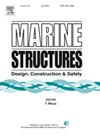软连接模块化海上浮动光伏阵列的数值研究
IF 5.1
2区 工程技术
Q1 ENGINEERING, CIVIL
引用次数: 0
摘要
海上浮动光伏(FPV)由于其丰富的空间和效率而成为一种可行的技术。然而,由于恶劣的环境条件,在海上环境中部署FPV具有挑战性。本文研究了最近开发的FPV概念,该概念采用轻型半潜式浮子,带有软连接,适用于海上条件,以解决技术和经济挑战。该研究旨在通过数值模型深入了解所提出的FPV设计的动态行为。水动力模型基于势解器WADAM。在时域软件SIMO-RIFLEX中研究了浮子的刚体运动和受波浪激励的柔性结构单元的动力学。利用已有的实验结果对时域数值模型进行了标定和验证。结果表明,在规则波浪和不规则波浪条件下,浮子运动和系泊张力的数值模拟结果与实验结果吻合较好。采用参数化方法研究了系缆预张力和刚度对浮子运动响应的影响。数值研究的结果为类似系统的进一步设计优化和开发提供了有价值的见解。本文章由计算机程序翻译,如有差异,请以英文原文为准。
Numerical study of soft-connected modular offshore floating photovoltaic array
Offshore floating photovoltaics (FPV) has emerged as a viable technology due to abundant space and efficiency. However, deploying FPV in offshore environments is challenging due to harsh environmental conditions. This paper studies a recently developed FPV concept with a lightweight, semi-submersible float with soft connections for offshore conditions to address the technical and economic challenges. The study aims to obtain insight into the dynamic behaviour of the proposed FPV design with a numerical model. The hydrodynamic model is based on the potential solver WADAM. The rigid body motions of floats with the dynamics of flexible structural elements subjected to wave excitations are studied in time-domain software SIMO-RIFLEX. The time domain numerical model is calibrated and validated by using available experimental results. The results from the numerical simulation are found to match the experimental results on the float motions and mooring tensions satisfactorily under regular and irregular wave conditions. A parametric study is carried out to examine the effect of mooring line pretension and stiffness on the motion response of the FPV floats. The findings from the numerical study provide valuable insight for further design optimisation and development of similar systems.
求助全文
通过发布文献求助,成功后即可免费获取论文全文。
去求助
来源期刊

Marine Structures
工程技术-工程:海洋
CiteScore
8.70
自引率
7.70%
发文量
157
审稿时长
6.4 months
期刊介绍:
This journal aims to provide a medium for presentation and discussion of the latest developments in research, design, fabrication and in-service experience relating to marine structures, i.e., all structures of steel, concrete, light alloy or composite construction having an interface with the sea, including ships, fixed and mobile offshore platforms, submarine and submersibles, pipelines, subsea systems for shallow and deep ocean operations and coastal structures such as piers.
 求助内容:
求助内容: 应助结果提醒方式:
应助结果提醒方式:


